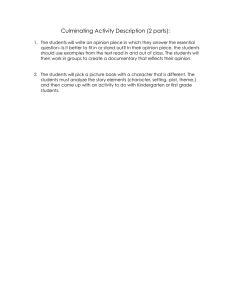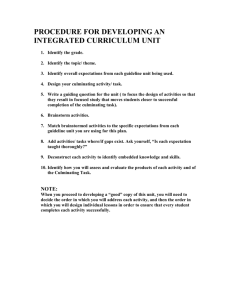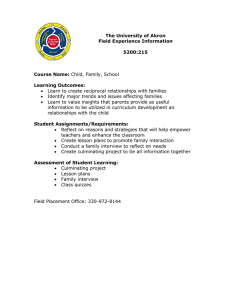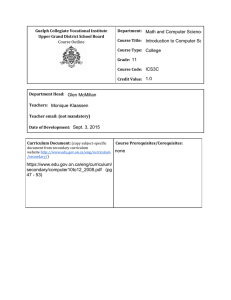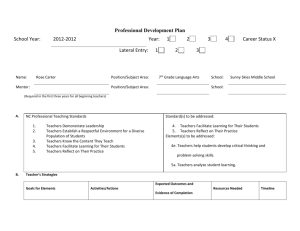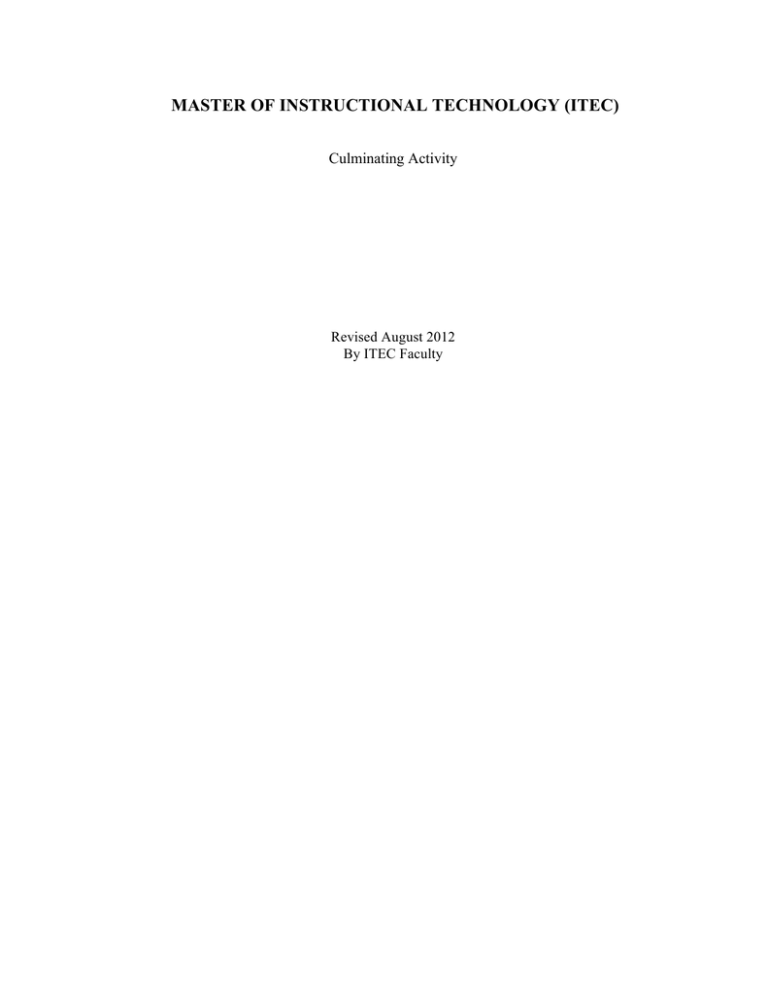
MASTER OF INSTRUCTIONAL TECHNOLOGY (ITEC)
Culminating Activity
Revised August 2012
By ITEC Faculty
Culminating Activity
Candidates in the Master’s of Instructional Technology program must complete a Culminating Activity to
meet graduation requirements. The Culminating Activity is a partial fulfillment of the requirements of the
Master’s Degree in Instructional Technology at the University of Central Arkansas. The purpose of the
Culminating Activity is to demonstrate a candidate's ability to create professional-quality projects
(product or research study) synthesizing what she or he has learned in the program. The Culminating
Activity must have academic significance and must be completed under the guidance of the candidate's
advisor. The project, as a general rule, will be in the candidate's area of specialization in the graduate
program.
Eligibility Requirements
Matriculated candidates in the ITEC program are eligible to pursue the Culminating Activity once ALL
of the following criteria have been met:
1) Completion of a minimum of 27 credit hours of which no more than one non-core course is left
for completion.
2) Establishment of a mentoring advisor.
3) Submission and approval of the Culminating Activity proposal before the final semester begins.
Culminating Activity:
The Culminating Activity shall consist of a functional product or a research study with a supporting paper
and an oral presentation. The project must be accompanied by academic components such as a clear
purpose, problem analysis, reflective findings, etc. The completed Culminating Activity consists of a
product or research study you have developed and a written document. Your project advisor will review
your Culminating Activity. If approved, the advisor will then forward the project to the Program
Coordinator for final approval. You should provide up-dated paper and deliverables every two weeks,
and meet on a regular basis (at least once a month recommended) with your advisor throughout the
project’s development to avoid complications at the final review. If your advisor asks you to change or
rewrite portions of your Culminating Activity after his/her review, you will have little time to make the
revisions before the end of the semester. The ITEC program coordinator will review all Culminating
Activity’s approved by your advisors. If approved by the program coordinator, he/she will sign off to
officially denote completion of the Culminating Activity requirement. The program coordinator will then
forward the project to the advisor for assigning of a grade.
Culminating Activity Presentation
After successfully completing the culminating activity, candidates will showcase their work at a
presentation open to ITEC Faculty. This presentation will be an opportunity for you to share your
accomplishment with fellow candidates, faculty, and others. It is expected that all candidates who
complete their culminating project will present.
Topic Criteria
The Culminating Activity topic should include these components:
• A clearly defined instructional problem – one that requires designing or redesigning an
educational/training experience.
• The appropriate use of some instructional technology (computer, WWW, video, etc.) as a major
component of the solution to the problem.
• A strong rationale for why the problem is important and how technology can be utilized.
• Practicability of the topic – is it reasonable to expect that the candidate can complete the project in
•
the given time constraints?
Clear that the candidate will produce instructional material as part of the project if project is not
developed for direct use in instruction.
Culminating Activity Proposal Guidelines The Culminating Activity Proposal is a written document that identifies the instructional purpose or topic
of the Culminating Activity: the reason the topic should be considered important, and how the project
will be carried out. In essence, the proposal is a draft of the first three sections of the Culminating
Activity paper.
As a general guide, the document should be approximately 12 pages in length, double-spaced and in 12point font with 1-inch margins. The document should follow the outline below:
1) Title Page
a. Title of Project
b. Author
c. Advisor
d. Date Submitted
2) Chapter 1 - Introduction (approximately 5 pages)
a. Introduction -clearly identify the instructional purpose or problem
b. Analysis - identify why the project is needed
i. Needs/goal analysis
ii. Learner and context(environmental) analysis c) Goals and Objectives - identify
proposed solution, instructional goals and objectives
3) Chapter 2 - Brief Review of the Literature (minimum of 4 pages)
a. Identify relevant literature pertaining to your proposed Culminating Activity topic
b. Review a wide variety of resources with an emphasis on primary sources
4) Chapter 3 – Methods and Procedure Plan (minimum of 4 pages)
a. Clearly specify how you plan for developing your product
b. Describe product including storyboards, flow charts, etc.
c. Provide a feasible timeline for completion of the Culminating Activity
5) References
6) Appendices
Culminating Activity Guidelines The Culminating Activity consists of an academic paper, a deliverable product and an oral presentation.
Academic paper - The paper should follow the American Psychological Association (APA) style, as
th
defined in the 6 edition of the Publication Manual of the American Psychological Association (2010).
As a general guide, the paper should be approximately 30 pages in length, double-spaced, in 12-point font
with 1-inch margins. The paper should follow the outline below:
1) Title Page (see sample)
This page is the first page of the paper. Include the title, author’s name, and date following the Title
Page example using inverted pyramid style. The date on this page is the month and gear of
graduation. Do not number this page.
2) Advisor Consent Form (see example)
This is the second page in the document. Do not number this page.
3) Disclaimer Page
This page is optional. See Publication for more information.
4) Acknowledgements (optional, one page maximum) - Section to express appreciation to faculty,
colleagues, family, etc.
5) Abstract (350 words maximum in a separate page) - Summary of the purpose and content of the
Culminating Activity
6) Table of Contents
a. Entries for abstract, chapters, main headings and subheadings
b. List of tables, figures, diagrams, etc.
c. Appendices and references
7) Chapter 1 – Introduction (approximately 6 pages)
a. Introduction - identify the instructional purpose or problem
b. Needs Analysis- identify why project is needed, needs/goal analysis
c. Goals and Objectives - identify proposed solution, instructional goals, objectives and expected
results
d. (Revise, expand and/or clarify information presented in proposal)
8) Chapter 2 - Literature Review (approximately 7 pages)
a. Clarify relevant literature organized by subject headings
b. Provides context for Culminating Activity topic
c. Review a wide variety of resources with an emphasis on primary sources
9) Chapter 3 – Methods and Procedure (approximately 5-6 pages)
a. Identify what you actually did to achieve your objectives
b. Describe software used and problems encountered
c. Describe actual product created or other viable option used to solve problem
10) Chapter 4 – Implementation and Evaluation (approximately 4-5 pages)
a. Presentation of results from pilot testing of your product
b. Describe evaluation tools and techniques
c. Discuss how evaluation results were implemented and changes to initial project
11) Chapter 5 - Conclusions and Discussions (approximately 4-5 pages)
a. Summary of project development
b. Conclusions
c. Reflections on lessons learned and implications for the future
12) References
13) Appendices
Product or Research Study - The culminating activity must be functional (applied research
methodology), of professional-quality and demonstrate the candidate's ability to apply skills and
knowledge in the area of instructional technology.
Oral Presentation - An oral presentation is scheduled at the end of the Fall and Spring semesters to
allow graduates to present their Culminating Activity to the ITEC Faculty.
Format Guidelines The guidelines below must be used for formatting your paper.
th
For formatting other than listed, follow the 6 edition of the Publication Manual of the American
Psychological Association (2010).
Final Copies - Submit unbounded two copies of the final paper
Paper & Printing - 8 1/2" x 11" and white paper. A laser quality printer should be used for the final copy.
Margins - One inch margin for each side (left, right, top and bottom). Everything including number
and footnotes must be placed in this margin area.
Publication One of the primary purposes of the professional paper is to provide students opportunities to make a
contribution to the profession by sharing the results of their research efforts through publication in
professional journals and presentations at professional meetings. Students are therefore urged to submit
their papers to appropriate journals for publication and/or submit proposals for presentations of their
papers at conferences of professional organizations. Advisors for professionals papers will provide
candidates with guidance in selecting appropriate vehicles for disseminiation of their research efforts.
Students may elect to include within their professional paper a disclaimer giving permission to any
faculty member within the department to edit their completed professional paper and to submit the paper
for publication or presentation. In those instances where permission to edit and publish or present the
student’s research is given, the student’s name will appear as first author therby clearly indicating the
student as primarily responsible for intellectual content. The disclaimer page, if used, appears with the
professional paper immediately following the title page.
(Sample Title Page)
Title of the project
by (First name Middle name Last name )
Submitted in Partial Fulfillment of the Requirements for the Degree of
Master of Instructional Technology
University of Central Arkansas
May, 2009
Copyright © Firstname Middlename Lastname, 2009. All rights reserved.
(Sample Culminating Activity approval page)
To the graduate school: The Culminating Activity of (your name) is approved:
(Type the name of your advisor)
(Type the name of the program coordinator)
(Date)
ITEC Culminating Activity Scoring Rubric
Advisor Consent Form I, (Project Advisor), agree to serve as advisor for the Culminating Activity of (Name of Candidate) in
fulfilling the requirements for the Master’s Degree in Instructional Technology.
___________________________________
Signature of candidate
___________________________________
Signature of advisor
___________________________________
Date
Criteria
Organization
and Format
(APA)
Insufficient – 1 point
Basic – 2 points
Proficient – 3 points
The sequence of ideas is
very difficult to follow.
Transitions are weak and the
meaning is often unclear.
The paper is not formatted as
designated in the assignment
sheet.
There are some incomplete thoughts
or ideas that are unclear. The paper
is only partially formatted as
designated in the assignment sheet.
Four or more syntax and/or grammar
errors were present within the paper.
Thoughts and ideas are
presented in a logical,
interesting sequence that
the reader can easily follow.
The paper is formatted as
designated in the
assignment sheet.
Chapter 1 – Introduction (Approximately 6 pages)
Introduction
The purpose is not clearly
The purpose is evident but needs to
defined.
further development.
Needs Analysis
A needs analysis was not
evident.
Needs analysis was evident, but
incomplete.
Goals and
Objectives
The goals and objectives are
not clearly defined.
The goals and objectives are evident
but needs to further development.
Chapter 2 – Literature Review (Approximately 7 pages)
Relevant and
Literature review is irrelevant
Literature review needs more
Organized
and unorganized.
relevance and organization.
Context
Sources
Literature does not provide
context for culminating
activity.
Review of sources revealed a
lack of a wide variety of
resources. Sources used
were irrelevant.
Context of literature review needs
further explanation.
More quality sources needed.
Chapter 3 – Methods and Procedures (Approximately 4-5 pages)
Methods
Methods were not evident.
Methods were confusing and need
further development.
Software
There was no description of
Description of software used needs
Explanation
software used. Did not
further development. Descriptions of
address problems
problems encountered were
encountered.
inadequate.
Product
Did not describe the product
Product created needs further
Description
created.
description.
Clearly identifies the
instructional purpose or
problem.
A needs analysis was
performed and clearly
stated.
The goals and objectives
are evident, clearly stated,
and well developed.
Literature review is relevant
and organized by subject
headings.
Literature review provides
explicit context for
culminating activity.
Review a wide variety of
resources with an emphasis
on primary sources
Methods were clearly stated
and replicable.
Clear description of
software used in project, as
well as problems
encountered.
Sufficiently described the
product created.
Chapter 4 – Implementation and Evaluation (Approximately 4-5 pages)
Results
Did not present results of
implementation of project.
Results are evident, but need to be
more clearly stated.
Evaluation
Tools
Evaluation tools and
techniques were not
addressed, stated nor clearly
defined.
Did not discuss how
evaluation results were
implemented. Did not identify
changes needed to initial
product.
Evaluation tools and techniques
were evident but need further
development.
Evaluation
Results
Evaluation results and revisions to
final product need further
explanation.
Chapter 5 – Conclusions and Discussions (Approximately 4-5 pages)
Summary
Summary was not apparent.
Summary of project needs further
development.
Conclusions
Conclusion was not
Conclusion of project needs further
apparent.
development.
Reflections
Not clearly defined.
Needs further development of ideas.
Presentation
Did not present.
Presentation lacked organization and
did not adequately present project.
Result of project
implementation were clearly
stated and logically
presented.
Evaluation tools and
techniques are evident,
clearly stated, and well
developed.
Discussed how evaluation
results were implemented
and identified changes
needed to initial product.
Clearly summarized project.
Conclusion of results was
clearly stated.
Well developed.
Presentation was well
designed and a thorough
Awarded
Needs further development.
Total
representation of product
developed.

